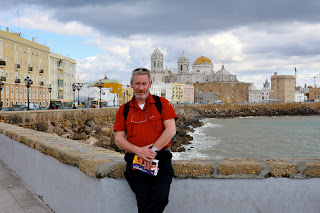Rihla (The Journey) – was the short title of a
14th Century (1355 CE) book written in Fez by the Islamic legal scholar Ibn
Jazayy al-Kalbi of Granada who recorded and then transcribed the dictated
travelogue of the Tangerian, Ibn Battuta. The book’s full title was A Gift to Those who Contemplate the Wonders
of Cities and the Marvels of Travelling and somehow the title of Ibn
Jazayy's book captures the ethos of many of the city and country journeys I
have been lucky to take in past years.
This
rihla is about Baelo Claudia, on the southwest coast of Spain.
The Guadalquivir river (from
Arabic al-wadi al-kabir “Great River) flows into the Atlantic Ocean via the Las
Marismas marshlands at the Gulf of Cadiz in the south west of Spain. The
Phoenicians founded Cadiz (Gadir “walled city”) about 1100BCE and they named
that great river the Beatis. It was navigable at that time as far as modern day
Córdoba (Carthaginian ‘Kart-Juba’) and when the Romans defeated the
Carthaginians in the second Punic War (c.206BCE) they rapidly colonised the
triangular valley area that spread south westwards from Córdoba which was centred
on the Baetis river and was framed to the north by the Sierra Morena, the Baetic
Cordillera to the south and the Atlantic to the west; all barriers great. The
Romans were to name the province Hispania Ulterior Baetica.
Taking the E5 Atlantic coastal
highway south from Cadiz towards Tarifa you are immediately stuck by the
absence of the concrete high-rise developments that punctuate every patch of
Mediterranean coast between Gibraltar and the French-Spanish border north of
Barcelona. This is the true attraction of the area and you wonder why?
Spain is a mountainous country
surrounded by a strip of coastal flatlands from 2-10km deep, coastal flatlands
that laid deserted on the eastern and southern shores for millennia because of the raiding activity of Mediterranean pirates, who then sold their human booty into slavery. From the
Cicilian pirates of Roman times to the Barbary pirates of Algiers, Tunis and
Sale-Rabat up the early 19th Century the meerest hint of a raid over
2000 years, sent coastal fisherman, salt-makers and farmers scattering quickly for
their base villages in the nearby defendable mountains. It was this defensive migration
of the population that left, apart from heavily fortified ports like Malaga, an
undeveloped and untitled strip of costal land, to be the target of the modern developers
who exploited the vacuum that previous pirates had created by menace.
Cadiz
The south-western coastal strip
in contrast has long been protected from piracy by the prevalent lee shore of
Atlantic winds that made sea-borne raiding difficult (dire for pirates but
delight for windsurfers!) and yet the lack of coastal urban development also has
its roots I suspect in the response to piracy but for very opposite reasons.
Cadiz has always been the pre-eminent naval base of Spain, even from earliest
times when the Phoenicians plied their trade, and for every naval galley of
Romans, or ships-of-the-line of the 16th and 17th
centuries you needed sailors to man those ships. As a consequence urban
development would not have been likely to take place along the nearby coast
because any able fisherman available would have been quickly “press ganged”
into the fraught and dangerous life of the naval services of the State.
Mediterranean Pirate hunter Andrea D'Auria on Vatican wall map
Inscription reads 'Pirates bitterest enemy'
(A little difficult if all the galley oarsmen are facing the wrong way as depicted here)
Inscription reads 'Pirates bitterest enemy'
(A little difficult if all the galley oarsmen are facing the wrong way as depicted here)
For this reason and the exposure
to Atlantic moods the geography and land usage has not changed much from the
Baetica of Roman times when the coastal route from Cadiz featured on such extant
descriptions of journeys to the south and the east as the Antonini Itinerary, a
rare descriptive summary of the way stations and towns on the major roads of
the Roman Empire. And I thought of this as I turned off the E5 autoroute and
winded my way the 10km to Bolonia beach and the car park of the interpretative
centre of Baelo Claudia, an almost preserved ‘dolls house’ of a Roman outpost
town.
The information detailed in the
Antonini Itinerary had been derived from the survey of the entire Roman world
commissioned during the dictatorship (and third consulship) of Julius Caesar,
as part of his huge civil reform agenda including that of the calendar, after
his return from Egypt about 46 BCE. As part of his land reform programme he had
brought back with him from Egypt four Greek surveyors of the famous
mathematical school in Alexandria, Nichodoxus, Theodocus, Polyclitus and
Didymus, placed them under the operational command of the young general Marcus
Agrippa, and delegated them to conduct a Descrptio orbis Romani.
A Roman Surveyor and his Groma
The intent of Caesar to comprehensively
survey the entire Roman empire had been prompted in the main by the mutiny of
the IX Roman Hispanic Legion three years earlier when he had difficulty in
settling the veterans of the disbanded legion after their conquests in Spain with
the promised rewards of lands for their efforts. In order to overcome that particular
difficulty Caesar had got four of his supporters; the praetors L.Roscius &
A. Allienus, the army commander in Spain Q.Fabius, the governor of Sardinia
S.Peducaeus and a Roman senator Maximilius to co-sponsor the land-reform law Lex mamilia roscia peducaea alliena fabia
in order to facilitate the urgent settlement.
Caesar, along with perhaps
Alexander and Napoleon, was both a pragmatist and a visionary. His world-view
was shaped by the need to know of what was possible and he realised that the
expanding legions of the Roman Imperium would demand greater and greater
‘reward’ settlement by victorius soldiers. He needed to now what was out there
and where it was.
The Alexandrian Greek agrimensori
with their gromas packed were dispatched by Agrippa to the four corners of the
Roman world: Nichodoxus to the east, Theodocus to the north, Polyclitus to the
south and Didymus to the west. Julius Honorius reported in his 5th
century Cosmographia that the entire survey took 32 years (Nichodoxus’ work
took 21 years 5 months and 9 days, Didymus’ 26 years 3 months and 17 days,
Theodocus’ 29 years 8 months and Polyclitus’ 32 years 1 month and 20 days) and
the information was ultimately presented to Marcus Agrippa and Caesar’s
nephew-heir the Emperor Augustus about 13 BCE. Marcus Agrippa died shortly
afterwards and it was his sister, Polla Vispania Agrippa who collated the
information, and commissioned a map that was erected in the Porticus Vispania
on the western edge of the Campus Agrippae near where the Piazza Colonna in
Rome is now situated.
Of equal importance for the
development of world geographical knowledge is that the Greek surveyors remained
true to their Alexandrian roots and copies of all the information they had
obtained also made its way back to their home school, information which
Claudius Ptolemy was to fully utilize in his great treatise and world
projection Geographica about 130 CE.
Baelo was founded about 200 BCE
and was the port and emporium for trade with Tangier (Tingris) 30 Roman miles
(1.375 km to a Roman mile) to the south across the Straits of Gibraltar in
Roman Mauretania and was 53 Roman miles from Cadiz. When Didymus arrived to
survey the town around 20 BCE it was thriving and had developed its own mint. By
virtue of its economic strength its inhabitants were granted citizenship of
Rome by the Emperor Claudius in 50 CE and the town was renamed Baelo Claudia.
Baelo Claudia however is I think
unique. When Didymus came calling around c.20 BCE (or as I was two thousand
years later) he would I am certain, as I was, have been amazed by the
‘dolls-house’ compact nature of the city where every aspect of the religious-legal-symbolic
dictates of Roman urban planning had been incorporated into a town that was
only 300 metres wide in an east-west direction and 600 metres long in a
north-south direction comprising about 13 hectares. Baelo Claudia was an easy
stopover to survey on his 26 year journey.
The Decumano Maximo, the main
paved East-West road of Roman towns in Baelo Claudia measures about 300 metres
from entrance gate to gate and borders a small but perfectly planned forum.
There is also a small theatre, that could seat 1000 people, a private temple
complex of Isis, and a public capitolium with the three temples in miniature
dedicated to Jupiter, Juno, and Minerva. Besides all this squeezed into the
small enclosed town are the obligatory public baths, a marcellum market-place
and the basilica judicial palace where a reproduction statute of Trajan stands
today, a Baetican-born emperor of the Roman Empire when Baelo Claudia was at
its apogee.
Intersecting the Decumano Maximo is the normally colonnaded Cardo
Maximo, the main north-south street in any Roman city. To give some idea of the
miniature but perfectly formed scale of Baelo Claudia it measures about 300
metres in length, down from the temple of Isis to the Decumano. By way of
contrast in another Greek-Roman town I visited in Syria, Apamea the colonnaded
Cardo Maximo runs for 2.2 km.
Trajan in Basilica in Baelo Claudia
Like a Victorian ‘dolls house’
Baelo Claudia is a microcosmic and very tangible time-capsule of everything
that Roman city planning was and well worth a visit.
Footnote:
For some reason despite
his 26 years of effort Didymus was subsequently eradicated from history when
the medieval monks started drawing up their maps. In the bottom left hand
corner of the famous 1290 CE Hereford Mappa Mundi there is a depiction of the
Emperor Augustus commissioning the survey of the world from the Greek
surveyors. The text of the edict that August is
holding says, Exiit edictum ab Augusto Cesare ut describeretur huniversus orbis (In those days a decree was issued by the emperor Augustus for a registration
to be made throughout the Roman world.)
In
addition to getting the name of the commissioning Caesar wrong, Richard de
Bello the author of the Hereford map depicts only three surveyors: Nichodoxus, Theodocus and Polyclitus. Didymus
for all his efforts is missing! A reason may lie in the fact that Hereford map
is based on the tripartite T/O design which using the Mediterranean as a
central division divides the map into three continents, Europe to the north,
Africa to the South, and Asia to the East. It is displayed with the east or
oriens to the top. Perhaps given this “God Inspired” map layout the medieval prebend
of Hereford Cathedral de Bello could see no theological reason for having a
fourth surveyor of an unknown continent to the west. Also Didymus in Greek
means ‘twin’ and perhaps his information was ascribed to one of the other
surveyors, who may or may not have been his twin brother.
Caesar Augustus and the 'Three' Surveyors on the Hereford Mappa Mundi
I suspect all four surveyors made
it back to Alexandria, where their efforts were rewarded 150 years later with the
majestic work of geography of Claudius Ptolemy.








































